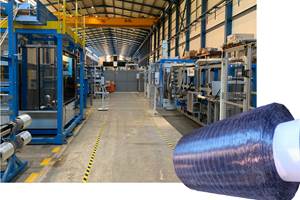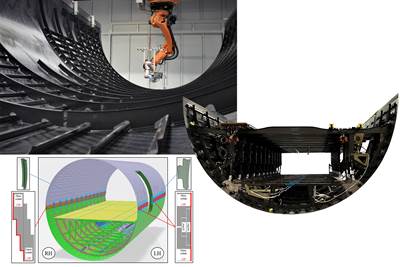MFFD longitudinal seams welded, world's largest CFRTP fuselage successfully completed
Fraunhofer IFAM and partners have completed left and right welds connecting the upper and lower fuselage halves and sent the 8×4-meter full-scale section to ZAL for integration with a cabin crown module and testing.
Share
The MFFD aircraft fuselage segment joined by thermoplastic welding at the Fraunhofer-Gesellschaft in Stade. Source | Fraunhofer IFAM
As part of the EU-funded Clean Sky 2/Clean Aviation project, “Large Passenger Aircraft” (LPA), Fraunhofer (Stade, Germany) and its international project partners have joined together upper and lower 8-meter-long and 4-meter-diameter shells of the Multi Functional Fuselage Demonstrator (MFFD) using automated positioning and welding of the two longitudinal seams. This is considered to be the largest carbon fiber-reinforced thermoplastic (CFRTP) aircraft fuselage segment in the world.
The MFFD represents a new architecture for automated production of a thermoplastic composite aircraft fuselage demonstrated on a 1:1 scale. The project shows potential for ~10% weight reduction and 10% cost savings in high-rate production.
Upper and lower shells: The thermoplastic lower shell, solidified (consolidated) in an autoclave under pressure and temperature, was provided by a consortium of GKN Fokker, Diehl Aviation, Netherlands Aerospace Centre – NLR and Delft University of Technology as part of the STUNNING project. The thermoplastic upper shell, manufactured using the tape laying process (in-situ consolidation), comes from a consortium of Premium Aerotec, Airbus, Aernnova and the German Aerospace Center – DLR ZLP.
Both shells have a high degree of pre-integration, with an almost rivetless architecture and a resulting weight reduction of 10% compared to the status quo. Automated pre-integration also opens up the potential for increasing efficency and local flexibility, as all components no longer have to be brought into the closed fuselage and assembled there manually in cramped conditions. Moreover, weight reduction of the aircraft structure leads to improved fuel efficiency during operation.
CO2 laser and ultrasonic welding. Project coordinator Airbus, working with the MFFD project teams, chose CO2 laser welding for the left longitudinal seam and ultrasonic welding for the right longitudinal seam to join the upper and lower fuselage shells into an integrated fuselage section. Both processes offer the advantage of dust-free joining. However, they have not yet been used in production or in research for such large CFRP components and with the quality requirements needed here. The demand for dust-free joining results from first-time pre-integration of both shells with a large number of structural and system components that are also assembled by welding, which does not enable subsequent removal of dust and chips.
Automated assembly research platform. Together with its partner FFT Produktionssysteme, Fraunhofer designed and built the automated assembly research platform for the MFFD, including the central system and process control, at the Research Center CFK NORD (Stade, Germany) in the LPA project “Multifunctional automation system for Fuselage Assembly Line” (MultiFAL).
The MultiFAL assembly research platform with inserted thermoplastic fuselage shells of the MFFD at Fraunhofer-Gesellschaft in Stade. The yellow hexapod robots for holding and high-precision adjustment of the shape and position of the upper shell are clearly visible. Source | Fraunhofer IFAM
Other project partners then integrated their technology modules into the platform. Further tasks performed by Fraunhofer along the process chain initially included the take-up of the lower shell using a developed fixture, which allowed the lower shell to be aligned with high precision in the assembly space for the subsequent processes. The upper shell was then inserted using the overhead crane. All further process steps were fully automated. A field of 10 hexapod robots positioned the two shells in relation to each other with sub-millimeter precision, using laser sensors to set the optimum shape and position of the shells at all times and readjust them if necessary.
CO2 laser welding. For the laser welding process to achieve the left fuselage join, thin CFRTP butt straps up to 4.5 meters long were placed in layers along the longitudinal edges of both shells. The shells featured a stepped profile to receive the butt straps. All solutions for feeding, positioning and edge sealing the straps were developed by Fraunhofer in the LPA project titled “Butt strap integration technology development with tooling design, validation, implementation in major component assembly and operation” (BUSTI).
CFRTP butt strap (on the left) as connection of the two MFFD thermoplastic fuselage shells, joined by the CO2 laser welding end effector (on the right) in the BUSTI project, completed in the MultiFAL assembly research platform. Source | Fraunhofer IFAM
Within BUSTI, the straps manufactured by Fraunhofer were precisely positioned on the seam with a strap handling tool and integrated into the automated process by means of a rolling movement, so that the oscillating laser beam of the immediately following welding head, which was guided via mirrors, could continuously melt the contact lines formed between the strap and the shell surface. A pressure unit on the laser welding end effector pressed the strap against the upper and lower shell joints with a joining force of up to 1 ton, consolidating the weld seam in the same work step.
To prevent hig- pressure forces during welding from damaging the fuselage structure, a device for force absorption and dissipation ran synchronously within the resulting fuselage section. The laser welding process used an online monitoring and control system which enables direct digital data exchange for process optimization and quality assurance with a digital twin.
Automated gap filling. Because the straps and the stepped joining zones of the shells could not be joined together seamlessly due to unavoidable manufacturing tolerances and the degrees of freedom required for the positioning processes, small gaps with irregular widths remained. These would impair the quality of the welded joints and therefore had to be completely filled with thermoplastic material after the welding process — yet excess material had to be avoided under all circumstances.
The gap-filling end effector carries out the thermoplastic gap filling using an extruder after CO2 laser welding of the butt straps onto the fuselage shells in the BUSTI project. Source | Fraunhofer IFAM
Like the laser welding end effector, a compact extruder was guided along the previously created joining seams. This extruder heated thermoplastic material in granulate/pellet form and conveyed it to the gap. There, a nozzle ensured that the material filled the gap before it cooled and hardened. The local gap volume — which is decisive for the exact filling quantity — was measured immediately beforehand by a 2D sensor integrated into the same gap-filling end effector. That measurement was transmitted to the extruder system, which made it possible to dynamically calculate the locally required discharge rate in-situ, so that irregular gaps, 3-20 millimeters wide, were filled with the exact amount of molten thermoplastic material required at each point.
Ultrasonic welding: Automated ultrasonic welding was selected as the joining method for the right longitudinal seam in order to gain as many important insights as possible from the research work for later use in production. Compared to laser welding, only the thinner-walled fuselage seam sections — i.e., those outside the door environments — can be joined in this way. However, it offers lower occupational safety effort with no laser protection cell required and low investment in terms of synchronizing parallel processes.
The ultrasonic welding end effector from the WELDER project in front of the finished weld seam below the field of hexapod robots which maintain high-precision shape and position adjustment. Source | Fraunhofer IFAM
Fraunhofer also collaborated in the LPA project “Welding Equipment for optimized, fast and accurate LongituDinal barrEl joint closuRe” (WELDER) with partners CT Engineering Group, Aimen, Aitiip and Dukane. This collaboration has resulted in a fast, reliable and automated ultrasonic welding process for the longitudinal seam.
Like the laser welding process presented above, the automated continuous ultrasonic welding process uses an online monitoring and control system, which enables direct digital data exchange for process optimization and quality assurance with a digital twin.
Part of the Fraunhofer team in front of the completed MFFD at the Research Center CFK NORD in Stade, Germany. Source | Fraunhofer IFAM
Further R&D work and successful project completion. Subsequent coupling of the frames between the upper and lower shell by resistance welding in March 2024 by WELDER project partners concluded the research work on the MFFD at the Research Center CFK NORD in Stade, Germany. Fraunhofer presented on the successful and timely completion of the three projects in which it was involved during a final meeting on March 14, 2024 in Brussels, Belgium. These results were presented to independent experts and all partners contributing to the demonstrator.
The MFFD is the second Clean Sky 2 large-scale demonstrator with significant contributions from Fraunhofer, following the 1:1 scale platform for automated cabin assembly in the LPA project “Automated Cabin & Cargo Lining and Hatrack Installation Method” (ACCLAIM), which was successfully realized at the beginning of 2021.
Stacking the completed MFFD fuselage section on the specially developed lower shell holder, which also serves for transporting the entire fuselage section. Source | Fraunhofer IFAM
The MFFD thermoplastic composite fuselage section has already been shipped to the Center of Applied Aeronautical Research (ZAL)(Hamburg, Germany). There, it will be finalized with, among other things, the integration of a cabin crown module. It will then be used for further tests and demonstration purposes.
Together, with the knowledge gained from the MFFD demonstrator, Fraunhofer says it will make mature technology modules available for industrialization by interested companies. Other technologies will be incorporated into subsequent research projects in order to enable a greater increase in efficiency with even lower resource consumption in future production. In addition to aircraft fuselages, target structures include vertical tail planes and tank systems for cryogenic hydrogen. Outside of the aviation industry, terrestrial or sea vehicles are also the focus of technology transfer.
The results described were developed by Fraunhofer in cooperation with all project partners mentioned. On behalf of the project partners, Fraunhofer would like to thank the European Commission for the funding.
Related Content
Novel dry tape for liquid molded composites
MTorres seeks to enable next-gen aircraft and open new markets for composites with low-cost, high-permeability tapes and versatile, high-speed production lines.
Read MorePlant tour: Middle River Aerostructure Systems, Baltimore, Md., U.S.
The historic Martin Aircraft factory is advancing digitized automation for more sustainable production of composite aerostructures.
Read MorePlant tour: Albany Engineered Composites, Rochester, N.H., U.S.
Efficient, high-quality, well-controlled composites manufacturing at volume is the mantra for this 3D weaving specialist.
Read MoreInfinite Composites: Type V tanks for space, hydrogen, automotive and more
After a decade of proving its linerless, weight-saving composite tanks with NASA and more than 30 aerospace companies, this CryoSphere pioneer is scaling for growth in commercial space and sustainable transportation on Earth.
Read MoreRead Next
Fraunhofer IWS completes MFFD longitudinal fuselage joint using CONTIjoin technology
Thermoplastic composite upper and lower half shells for the Multifunctional Fuselage Demonstrator were welded using CO2 laser over a total length of 8 meters.
Read MoreManufacturing the MFFD thermoplastic composite fuselage
Demonstrator’s upper, lower shells and assembly prove materials and new processes for lighter, cheaper and more sustainable high-rate future aircraft.
Read MoreVIDEO: High-volume processing for fiberglass components
Cannon Ergos, a company specializing in high-ton presses and equipment for composites fabrication and plastics processing, displayed automotive and industrial components at CAMX 2024.
Read More
















